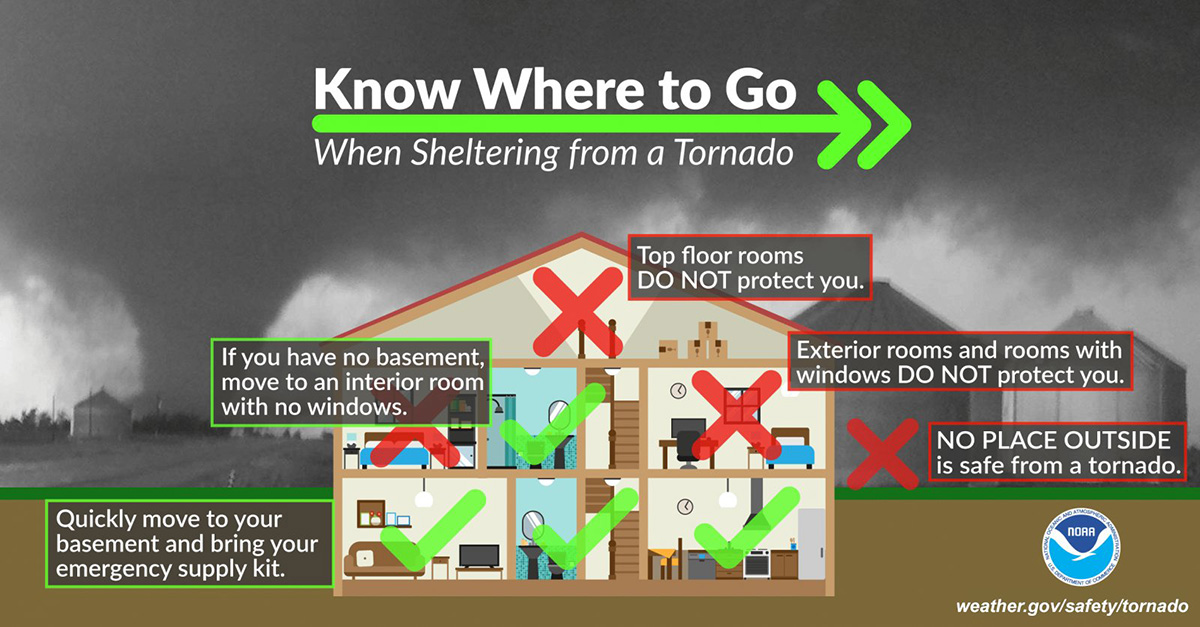
By Soni Cochran, Extension Associate, Lancaster County
The current situation with COVID-19 and social distancing rules do not eliminate the potential for a severe weather outbreak, including the possibility of tornadoes. However, it does require a little extra preparation for such an event as we are in the midst of severe storm season. Planning can reduce the danger should a tornado warning be issued.
The first step is to have an emergency plan for your household. The plan will include identifying the safest location for shelter in your home, preparing an emergency kit and checking your method of receiving alerts and warnings.
BEST PLACES TO SHELTER
If you live in a mobile home, there is no safe place to take shelter in that structure. Check with your park management on shelter capabilities and make plans accordingly. Verify these are open and available to you and the other residents despite the recent COVID-19 protocols.
If you live in an apartment complex, you may have bigger challenges. Check to see if your building or complex has a safe place to shelter during severe weather. If so, verify the shelter is open and available to you and the other residents despite recent COVID-19 protocols. If no shelter is available, check for space on the lowest level, without windows, and put as many walls between you and the outside as possible.
In a house without a basement, put yourself on the lowest level with as many walls between you and the outside as possible. Centrally-located halls and bathrooms are the safest location to seek shelter (see graphic below). If you have a basement, that is, by far, the best location to go. Sheltering under the stairwell may protect you from falling debris.
EMERGENCY KIT SUPPLIES
An emergency kit should consist of water (one gallon of water per person per day for at least three days, for drinking and sanitation), at least a three-day supply of non-perishable food, flashlight, first aid kit, extra batteries, whistle to signal for help, dust mask to help filter contaminated air, plastic sheeting and duct tape to shelter-in-place, moist towelettes, garbage bags and plastic ties for personal sanitation, wrench or pliers to turn off utilities, manual can opener for food and cell phone with chargers and a backup battery.
BEST OPTIONS FOR SEVERE WEATHER UPDATES
Smart phones and the internet are a common method of getting weather updates. You should also consider a backup method in case these systems are down. An NOAA weather radio is an important tool to receive these warnings. When purchasing a weather radio, make certain it has a signal in the location you will use for shelter and is programmed for your area.
NOW’S THE TIME TO PLAN AND PRACTICE YOUR PLAN
Many people are spending more time than normal at their residences. While this will provide additional challenges for individuals in apartment complexes, etc. – it does provide a fantastic opportunity for everyone to plan and rehearse. Disaster plans shouldn’t be limited to severe weather! Prepare and practice for fires, earthquakes and other disasters in this time of isolation.
During a disaster, what is good for you is also good for your pets, so get them ready today. Make sure your pets and any larger animals are included in your emergency preparedness plans. For more information, visit https://www.ready.gov/pets.
REMEMBER:
• In the case of a warning, your first priority is to protect yourself from a potential tornado!
• Have multiple modes of receiving an alert or warning – with at least one form of alert not reliant upon cellular communications. Set correctly for your area, an NOAA weather radio can provide important information without relying on cellular access.
• Identify the safest shelter location — either in your home or in a communal shelter.
• If using a communal shelter — i.e. mobile home park or apartment complex — confirm the shelter is open and what distancing practices are in place keeping in mind COVID-19 protocols.
This article was adapted from K-State Research and Extension, https://webapp.agron.ksu.edu/agr_social/article_new/severe-weather-preparedness-during-covid-19-381-8
For more severe weather safety tips visit:
• https://www.weather.gov/mob/Severe_Tornado
• https://disaster.unl.edu